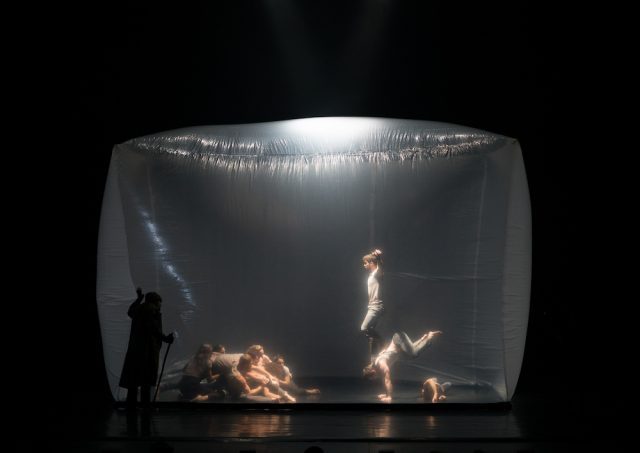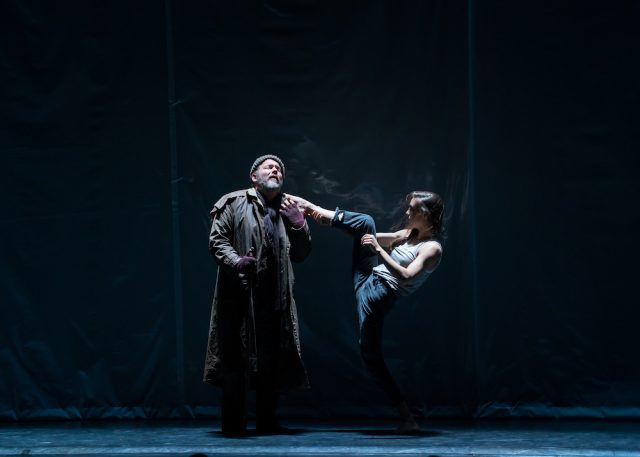
The ten members of Circa Ensemble are trapped in a cube in En Masse (photo © David Kelly)
Gerald W. Lynch Theater at John Jay College
524 West Fifty-Ninth St. between Tenth & Eleventh Aves.
October 23-25, $55-$95
Festival continues through November 24
www.lincolncenter.org
circa.org.au
Australia’s Circa Ensemble returns to Lincoln Center’s White Light Festival for the first time in five years with the death-defying, awe-inspiring En Masse, continuing at the Gerald W. Lynch Theater through October 25. Incorporating acrobatics and gymnastics into contemporary dance with flashes of balletic structures, the Brisbane-based troupe, which presented How Like an Angel at the Union Theological Seminary in 2014, has nothing less than the end of the world on its mind — and what happens after. Created by director and stage designer Yaron Lifschitz with the company, the evening-length work is divided into two related parts. In the first half, the ten extremely talented and brave dancers — Caroline Baillon, Marty Evans, Piri Lee Goodman, Keaton Hentoff-Killian, Cecilia Martin, Hamish McCourty, Daniel O’Brien, Kimberley O’Brien, Jarrod Takle, and Sandy Tugwood — break apart and come together to alternating music by Franz Schubert, Lieders from Schwanengesang (“Ständchen,” “In der Ferne,” “Der Doppelgänger”) and Winterreise (“Der Leiermann,” “Gute Nacht,” “Die Nebensonnen,” “Frühlingstraum”), and electronic music and noise from twenty-six-year-old Swedish composer Klara Lewis (“Msuic I,” “Want,” “Too,” “Beaming”).

Tenor Robert Murray beautifully sings Schubert Lieders in En Masse (photo © David Kelly)
The Schubert songs are marvelously sung by tenor Robert Murray, dressed like a vagabond with ratty clothing and carrying a tall, twisted walking stick (the costumes are by associate director Libby McDonnell), accompanied by Tamara-Anna Cislowska on a grand piano. The barefoot performers, wearing jeans and gray T-shirts, move in front of and behind a plastic curtain that comes down and raises again to reveal set changes. A woman crawls across the front of the stage, contorting her lower body into seemingly impossible positions. All ten dancers are trapped in a transparent inflated cube. A parade of solos, duets, and trios marches in the front. Three dancers build a precarious human pyramid, climbing on top of one another. The six men and four women run, jump, slide, get thrown, and threaten to fall against the hard floor — at one treacherous point the audience gasped loudly in unison as a man, fifteen feet in the air, falls, face forward. But Lifschitz has built in various fail safes to try to prevent any potential tragedies, unobtrusively using spotters, and the dancers, who have years of highly specialized circus and acrobatic training, are well-practiced at rolling into somersaults and other moves in case a lift, toss, or carry doesn’t go perfectly.
After intermission, the mood changes. Now that we’re familiar with Circa’s movement vocabulary and impressive skills, we’re not as worried about the safety of the performers, who have formed a kind of postapocalyptic community. All ten dancers are onstage for most of the second half, which is set to Igor Stravinsky’s Le sacre du printemps (“The Rite of Spring”), aggressively played by Cislowska and Michael Harvey on pianos that face each other at the back of the stage, and features dazzling lighting by Lifschitz and Richard Clarke. The situation is not quite as dire as the performers expand their repertoire, creating breathtaking formations, moving in unison, banding together to face the future. It’s no mere pie-in-the-sky hopefulness but a deep-seated belief in the innate instinct of humanity to forge ahead, to do whatever is necessary to survive and thrive. The first act is introduced by a quote from Italian philosopher Antonio Gramsci: “The crisis consists precisely in the fact that the old is dying and the new cannot be born,” while the second starts with a dictum from German philosopher Walter Benjamin: “There is no document of civilization that is not at the same time a document of barbarism.” En Masse is a document showing that something new can indeed be born, even in times of crisis and barbarism.